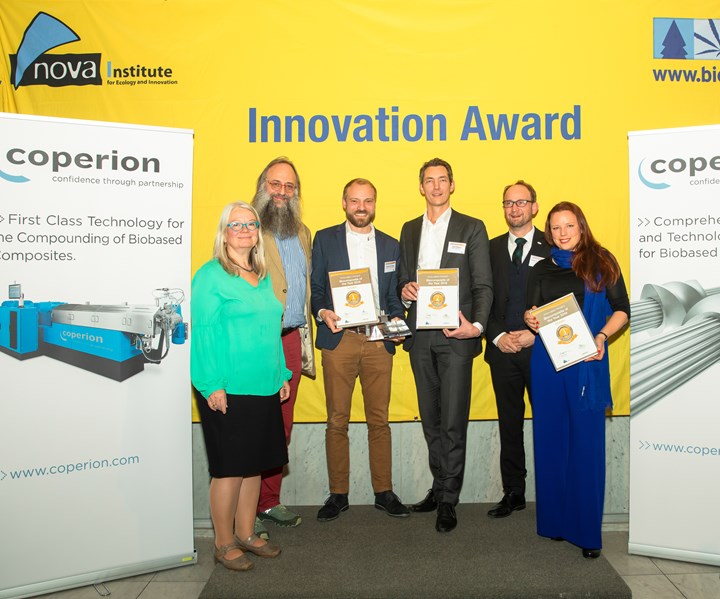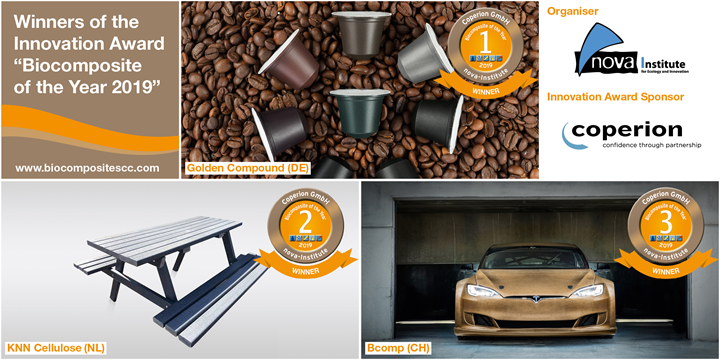Biocomposite of the Year 2019 winners announced
Announced at Nova-Institute’s Biocomposites Conference in Cologne, Germany, the winning entries use natural fiber composites for automotive and consumer goods applications.

Source | Nova-Institute
Nova-Institute (Hürth, Germany) recently announced the winners of its2019 “Biocomposite of the Year” innovation awards, which were presented at the 8th Biocomposites Conference Cologne on Nov. 14-15 in Cologne, Germany.
According to Nova-Institute, currently, up to 80% of plastics can be replaced by biogenic fillers such as wood flour and cork, or by natural fibers for reinforcement. By now, the company says, biocomposites are available for almost every application: packaging, consumer goods, toys, handles, shoes, façade and terrace elements, floors, car parts and even furniture.
This years’ nominated companies provided an overview of the growing application sectors for biocomposites, ranging from automotive applications to packaging, consumer goods, cladding, music instruments and façade elements.

Source | Nova-Institute
The top three winners were Golden Compound (first place), KNN Cellulose (second place) and Bcomp (third place). See the full list of finalists here.
First place: compostable coffee capsules reinforced with sunflower seed shell fiber
Designed by Golden Compound GmbH (Ladbergen, Germany), HOMEcap is said to be the world's first and only home compostable coffee capsule certified with “OK Kompost HOME.” It was launched on the market at the beginning of 2019. The HOMEcap is made from a compound comprising PTTMCC Biochems bio-based polymers PBS and PBSA mixed with sunflower seed shells and inorganic fillers. It comes with a paper- and cellulose-based lid that is sealable to the capsule without additional glue and is home compostable. The material composition is said to result in low oxygen transmission rates, and eliminates the need for additional barrier packaging. A VDI 4605 sustainability assessment showed that this capsule outperforms current state of the art capsules, like deep-drawn PP EVOH multilayer capsules, in terms of sustainability.
Second place: cost-competitive Recell biocomposites
KNN Cellulose (Leeuwarden, Netherlands) has commercialized Recell’s biocomposite material made from recycled toilet paper that is separated at a sewage treatment plant, and can be mixed with a variety of polymers such as bio-based polymers, PLA or PHA. The product is said to add value to previously unused cellulose waste streams, and the granules are suitable for standard injection molding and extrusion lines. Current applications include flower pots, claddings, fences, terrace planks and boxes. Recell took part in the competition with a picnic table from Ecodeck comprising cellulose fibers recovered from wastewater treatment plants using Cellvation technology. The treatment plants benefit from lower operating costs, increased processing capacity and the reuse of cellulose fibers that would otherwise be incinerated.
Third place: PowerRibs for sustainable lightweighting
Bcomp (Fribourg, Switzerland) has developed proprietary lightweighting solutions for high-performance applications by applying latest knowledge on composites to natural fibers. PowerRibs technology uses a reinforcing grid inspired by the thin veins in leaves, and that is said to provide maximum stiffness at minimum weight, enabling them to achieve the performance of carbon fibers in a motorsport body. The result is reportedly a 75% reduced CO2 footprint, 30% lower costs and improved safety without toxic dust and sharp shattering, as well as viable end-of-life options. PowerRibs are also said to reduce weight for car interior coverings by up to 40%.
Related Content
Carbon fiber, bionic design achieve peak performance in race-ready production vehicle
Porsche worked with Action Composites to design and manufacture an innovative carbon fiber safety cage option to lightweight one of its series race vehicles, built in a one-shot compression molding process.
Read MoreInfinite Composites: Type V tanks for space, hydrogen, automotive and more
After a decade of proving its linerless, weight-saving composite tanks with NASA and more than 30 aerospace companies, this CryoSphere pioneer is scaling for growth in commercial space and sustainable transportation on Earth.
Read MoreCutting 100 pounds, certification time for the X-59 nose cone
Swift Engineering used HyperX software to remove 100 pounds from 38-foot graphite/epoxy cored nose cone for X-59 supersonic aircraft.
Read MorePlant tour: Airbus, Illescas, Spain
Airbus’ Illescas facility, featuring highly automated composites processes for the A350 lower wing cover and one-piece Section 19 fuselage barrels, works toward production ramp-ups and next-generation aircraft.
Read MoreRead Next
Next-gen fan blades: Hybrid twin RTM, printed sensors, laser shock disassembly
MORPHO project demonstrates blade with 20% faster RTM cure cycle, uses AI-based monitoring for improved maintenance/life cycle management and proves laser shock disassembly for recycling.
Read MoreCutting 100 pounds, certification time for the X-59 nose cone
Swift Engineering used HyperX software to remove 100 pounds from 38-foot graphite/epoxy cored nose cone for X-59 supersonic aircraft.
Read MoreScaling up, optimizing the flax fiber composite camper
Greenlander’s Sherpa RV cab, which is largely constructed from flax fiber/bio-epoxy sandwich panels, nears commercial production readiness and next-generation scale-up.
Read More.jpg;width=70;height=70;mode=crop)












